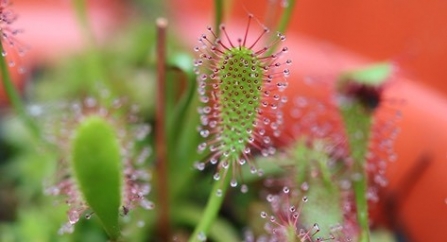Whilst many think of carnivorous plants as exotic man-eaters from jungle films, great sundew has a much smaller appetite. Rather than most plants that absorb everything they need through their roots, this species has evolved to thrive in acidic, low nutrient peat basins by getting its nutrition from insects. The leaves of the great sundew look like a hairbrush, with sticky, red ‘tentacles’ on one side. The plant waits for an insect to become stuck in its trap, before slowly rolling up its leaf and digesting its meal.
Carnivore grows for the first time in over a century in Cheshire
Great sundew c. Josh Styles

Great sundew c. Josh Styles
Josh Styles from the North West Rare Plant Initiative (NWRPI), who re-introduced the 15 plants on site said: “It’s amazing to see this totally vivacious insectivore in Cheshire once again, after it’s extinction during World War One. With reinforcement and monitoring of this reintroduction planned in the long-term, I have my hopes set on big population increases at the site!”
Over the years land use has changed in the UK, meaning peatlands have been polluted, dried and dug up for commercial compost and agriculture. Because this fascinating plant can only grow in peatlands, the great sundew was driven to extinction in Cheshire. This loss of peatland is not only bad for the wildlife that lived there, but it is also terrible for our fight against climate change.
Trees are most often associated with carbon storage. Despite peat bogs covering only 3% of the Earth’s surface, they store more carbon than all our forests combined. Regardless of this, 94% of our peatlands have been destroyed in England, releasing all the carbon they once stored. Peatlands take thousands of years to form, yet can be destroyed in an instant. It’s why Cheshire Wildlife Trust are managing and rewetting precious peatland across the county and south Manchester.
“We’re incredibly excited to see this interesting plant back in our region – where it belongs,” said Ben Gregory, Operations Manager West at Cheshire Wildlife Trust. “The site, owned by Forestry England, took over 7,000 years to form. Therefore it’s important to our heritage, as well as our wildlife to ensure it and all the other plants and animals that live here thrive for the next 7,000”
“Thanks to our supporters, we’re able to work with landowners and farmers to restore peatlands. We create pools and rewet areas, as well as remove ‘thirsty’ invasive plant species that would otherwise dry the land.”
This is the second plant species the NWRPI has reintroduced into a site managed by Cheshire Wildlife Trust. By working in partnerships like this, the hope is that wider landscapes will recover enough to provide the natural carbon solutions needed to help combat both the current nature and climate crisis.
Great sundew reintroduction (https://youtu.be/SZ7bboeHE_w)
c. Josh Styles
